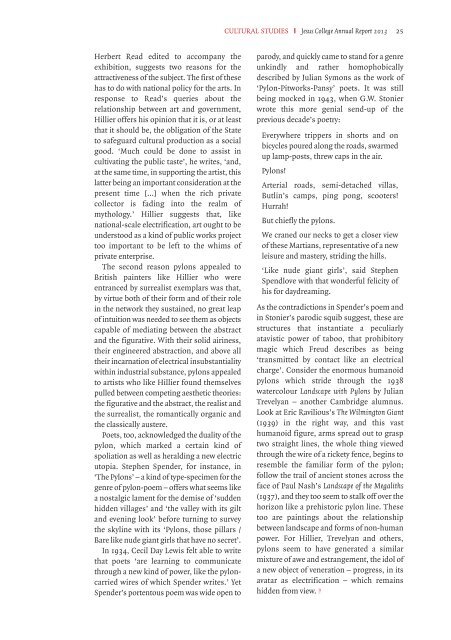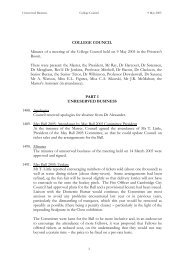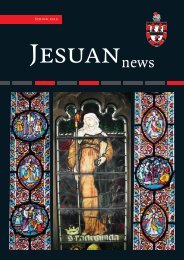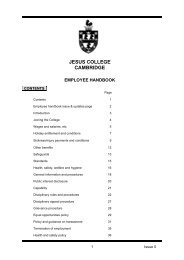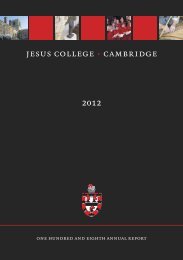2013 Annual Report - Jesus College - University of Cambridge
2013 Annual Report - Jesus College - University of Cambridge
2013 Annual Report - Jesus College - University of Cambridge
You also want an ePaper? Increase the reach of your titles
YUMPU automatically turns print PDFs into web optimized ePapers that Google loves.
CULTURAL STUDIES I <strong>Jesus</strong> <strong>College</strong> <strong>Annual</strong> <strong>Report</strong> <strong>2013</strong> 25<br />
Herbert Read edited to accompany the<br />
exhibition, suggests two reasons for the<br />
attractiveness <strong>of</strong> the subject. The first <strong>of</strong> these<br />
has to do with national policy for the arts. In<br />
response to Read’s queries about the<br />
relationship between art and government,<br />
Hillier <strong>of</strong>fers his opinion that it is, or at least<br />
that it should be, the obligation <strong>of</strong> the State<br />
to safeguard cultural production as a social<br />
good. ‘Much could be done to assist in<br />
cultivating the public taste’, he writes, ‘and,<br />
at the same time, in supporting the artist, this<br />
latter being an important consideration at the<br />
present time […] when the rich private<br />
collector is fading into the realm <strong>of</strong><br />
mythology.’ Hillier suggests that, like<br />
national-scale electrification, art ought to be<br />
understood as a kind <strong>of</strong> public works project<br />
too important to be left to the whims <strong>of</strong><br />
private enterprise.<br />
The second reason pylons appealed to<br />
British painters like Hillier who were<br />
entranced by surrealist exemplars was that,<br />
by virtue both <strong>of</strong> their form and <strong>of</strong> their role<br />
in the network they sustained, no great leap<br />
<strong>of</strong> intuition was needed to see them as objects<br />
capable <strong>of</strong> mediating between the abstract<br />
and the figurative. With their solid airiness,<br />
their engineered abstraction, and above all<br />
their incarnation <strong>of</strong> electrical insubstantiality<br />
within industrial substance, pylons appealed<br />
to artists who like Hillier found themselves<br />
pulled between competing aesthetic theories:<br />
the figurative and the abstract, the realist and<br />
the surrealist, the romantically organic and<br />
the classically austere.<br />
Poets, too, acknowledged the duality <strong>of</strong> the<br />
pylon, which marked a certain kind <strong>of</strong><br />
spoliation as well as heralding a new electric<br />
utopia. Stephen Spender, for instance, in<br />
‘The Pylons’ – a kind <strong>of</strong> type-specimen for the<br />
genre <strong>of</strong> pylon-poem – <strong>of</strong>fers what seems like<br />
a nostalgic lament for the demise <strong>of</strong> ‘sudden<br />
hidden villages’ and ‘the valley with its gilt<br />
and evening look’ before turning to survey<br />
the skyline with its ‘Pylons, those pillars /<br />
Bare like nude giant girls that have no secret’.<br />
In 1934, Cecil Day Lewis felt able to write<br />
that poets ‘are learning to communicate<br />
through a new kind <strong>of</strong> power, like the pyloncarried<br />
wires <strong>of</strong> which Spender writes.’ Yet<br />
Spender’s portentous poem was wide open to<br />
parody, and quickly came to stand for a genre<br />
unkindly and rather homophobically<br />
described by Julian Symons as the work <strong>of</strong><br />
‘Pylon-Pitworks-Pansy’ poets. It was still<br />
being mocked in 1943, when G.W. Stonier<br />
wrote this more genial send-up <strong>of</strong> the<br />
previous decade’s poetry:<br />
Everywhere trippers in shorts and on<br />
bicycles poured along the roads, swarmed<br />
up lamp-posts, threw caps in the air.<br />
Pylons!<br />
Arterial roads, semi-detached villas,<br />
Butlin’s camps, ping pong, scooters!<br />
Hurrah!<br />
But chiefly the pylons.<br />
We craned our necks to get a closer view<br />
<strong>of</strong> these Martians, representative <strong>of</strong> a new<br />
leisure and mastery, striding the hills.<br />
‘Like nude giant girls’, said Stephen<br />
Spendlove with that wonderful felicity <strong>of</strong><br />
his for daydreaming.<br />
As the contradictions in Spender’s poem and<br />
in Stonier’s parodic squib suggest, these are<br />
structures that instantiate a peculiarly<br />
atavistic power <strong>of</strong> taboo, that prohibitory<br />
magic which Freud describes as being<br />
‘transmitted by contact like an electrical<br />
charge’. Consider the enormous humanoid<br />
pylons which stride through the 1938<br />
watercolour Landscape with Pylons by Julian<br />
Trevelyan – another <strong>Cambridge</strong> alumnus.<br />
Look at Eric Ravilious’s The Wilmington Giant<br />
(1939) in the right way, and this vast<br />
humanoid figure, arms spread out to grasp<br />
two straight lines, the whole thing viewed<br />
through the wire <strong>of</strong> a rickety fence, begins to<br />
resemble the familiar form <strong>of</strong> the pylon;<br />
follow the trail <strong>of</strong> ancient stones across the<br />
face <strong>of</strong> Paul Nash’s Landscape <strong>of</strong> the Megaliths<br />
(1937), and they too seem to stalk <strong>of</strong>f over the<br />
horizon like a prehistoric pylon line. These<br />
too are paintings about the relationship<br />
between landscape and forms <strong>of</strong> non-human<br />
power. For Hillier, Trevelyan and others,<br />
pylons seem to have generated a similar<br />
mixture <strong>of</strong> awe and estrangement, the idol <strong>of</strong><br />
a new object <strong>of</strong> veneration – progress, in its<br />
avatar as electrification – which remains<br />
hidden from view.


